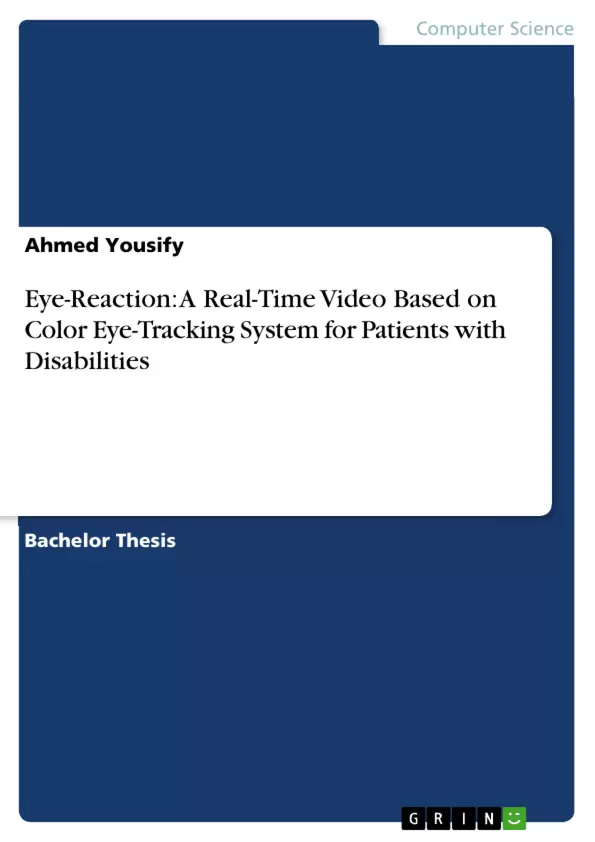The influence of vision is taking one-step ahead with the introduction of sophisti-cated eye-tracking and gaze-tracking techniques, which track the movement of the eye and the gaze location to control various applications. This paper describes in detail the low-cost hardware development and the software architecture for a real-time eye tracking based on color system using the open-source image-processing framework of AForge.NET. The designed system uses a USB camera to detect the eye movements and uses EuclideanColorFiltering to filter colors, and then it detects the biggest object between them and gets the location of that object. The system shows to the patient some question and answers according to the questions, he will look at one of the answers, then, it will be highlighted. By this way, the doctor will know what is wrong with the patient and what should be done to cure him. This provides a highly useful alternative control system for a person suffering from ALS or in Vegetative state of brain stroke. The software system is in Kurdish language and it is designed for the patient in a way to be relaxed and be as simple as possible. Test results on systems on the correct locations and error percentage shows the per-formance of the developed eye tracking system.
Inhaltsverzeichnis (Table of Contents)
- Chapter One: Introduction
- Background
- Eye Tracking Metrics Most Commonly Reported in Usability Studies
- Problem statement
- Objectives of the research
- Questions of the research
- Scope of the research
- Motivation of the research
- Significant of the research
- Research project outlines
- Chapter Two: Literature Review
- Chapter Three: Methodology
- Introduction
- Participants and Environment
- Tools
- Visual Studio
- Visual C#
- Aforge.NET
- Comparing Image-Processing Libraries
- Documentation and other material
- Ease of use
- Performance
- Materials and instruments
- Sunglasses
- Power Plug Adapter
- Webcam
- DATASHOW (Projector)
- Final Appearance
- Method
- Limitations
- Speed
- Lighting changes
- Transformations
- Scaling
- Rotation:
- Ethical considerations
- Chapter Four: Software System
- Log in Form
- Configuration form
- Questions Form
- Help and Sleep
- About
- Chapter Five: Results of the research
- Theoretical Results
- EXPERIMENTAL RESULTS
- Chapter Six: Conclusions and future works
Zielsetzung und Themenschwerpunkte (Objectives and Key Themes)
This thesis aims to develop a low-cost, real-time eye-tracking system, called Eye-Reaction, to facilitate communication between patients with disabilities and their doctors. The system utilizes color-based object detection, allowing patients to answer questions by gazing at the desired answer, which is then highlighted. The primary focus is on assisting patients with Amyotrophic Lateral Sclerosis (ALS), who experience full body paralysis and rely heavily on eye movements for interaction.
- Development of an eye-tracking system for patients with disabilities, particularly ALS.
- Exploration of color-based object detection for eye tracking.
- Implementation of a real-time video-based system using the AForge.NET framework.
- Evaluation of the system's accuracy and efficiency in practical settings.
- Potential applications of the technology in healthcare and other fields.
Zusammenfassung der Kapitel (Chapter Summaries)
Chapter One provides an introduction to eye-tracking technology, its applications in various fields, and the challenges faced by individuals with physical disabilities. It outlines the research problem, objectives, and scope, emphasizing the need for an accessible communication system for patients with ALS. Chapter Two presents a literature review on existing eye-tracking systems, highlighting their strengths and limitations. It explores various techniques and approaches used in eye detection and tracking, including color-based methods. Chapter Three discusses the methodology employed in this study, focusing on the participants, environment, tools, and instruments used. It delves into the technical details of the chosen image processing framework (AForge.NET) and explains the development process of the Eye-Reaction system. Chapter Four explores the software system's features and functionalities, describing the design principles and functionalities of the login form, configuration form, questions form, help and sleep form, and about form. Chapter Five presents the results of the research, including both theoretical and experimental findings. It analyzes the system's performance, emphasizing its ability to accurately track eye movements and provide reliable feedback. Chapter Six concludes the thesis by summarizing the findings, discussing the system's strengths and limitations, and exploring potential future directions for research and development.
Schlüsselwörter (Keywords)
This research focuses on developing an eye-tracking system for patients with disabilities, particularly ALS. Key concepts include color-based object detection, real-time video processing, AForge.NET framework, and accessible communication technology. The research explores the use of eye movements as a means of interaction and aims to improve the quality of life for individuals with limited mobility.
- Arbeit zitieren
- Ahmed Yousify (Autor:in), 2014, Eye-Reaction: A Real-Time Video Based on Color Eye-Tracking System for Patients with Disabilities, München, GRIN Verlag, https://www.grin.com/document/283044



